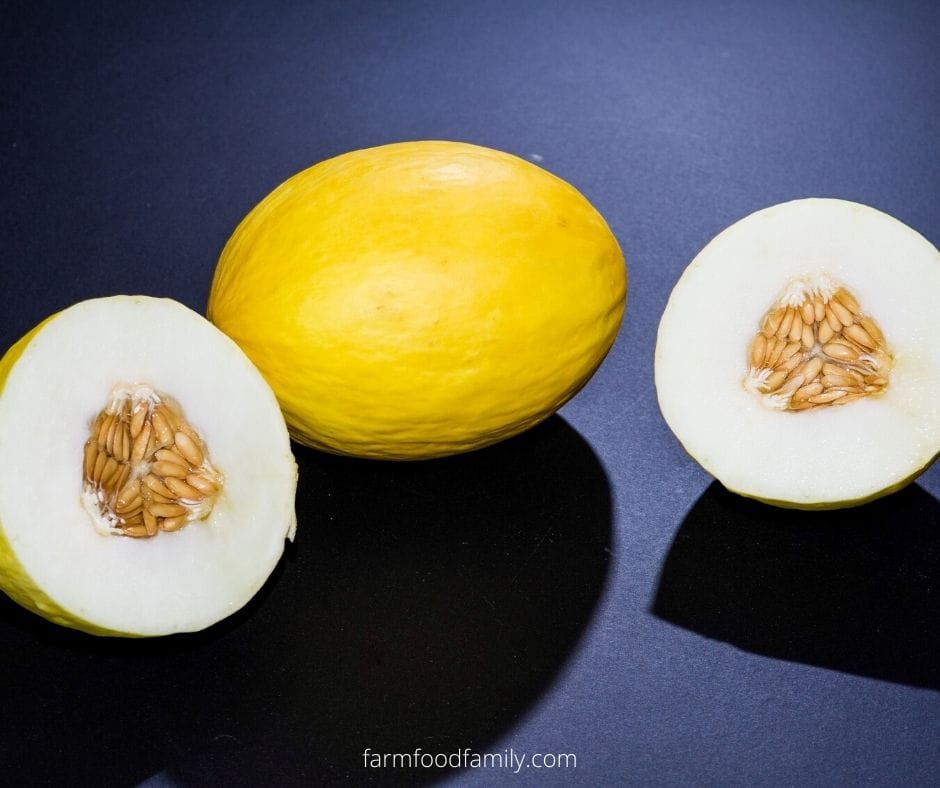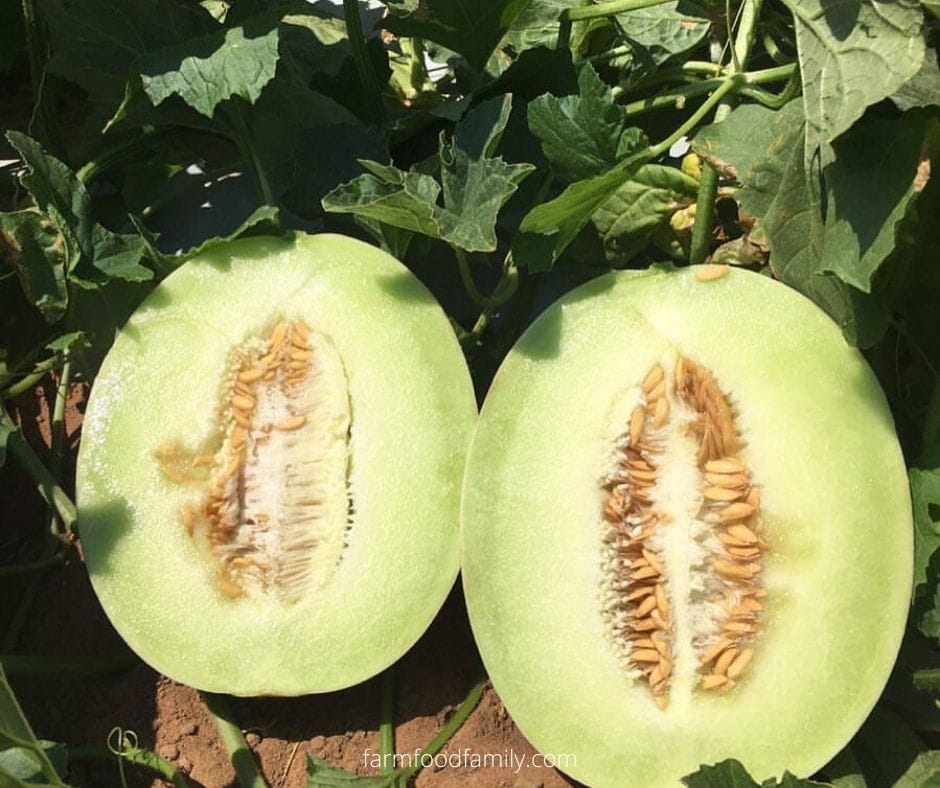In this article
40 Types of Melons
1.
It is considered as an old melon with its cultivation dating back to the 1800s.
Its level of sweetness varies but the sweetest ones are harvested in warmer regions.

Source: Knownyouseed
Its tropical flare makes it perfect for salads, desserts and cold beverages.
The fruits are distinct because they are long and slender (not round and bulky).
Its skin is pale green and its flesh is white, resembling the cucumber.

It was cultivated mainly in Armenia, Egypt and the rest of Asia in as early as the 1400s.
It is also watery albeit it size, making it a favorite for juices and smoothies.
It is called such because it ripens from mid-summer to fall.

It has a unique savory taste but with the aroma of a banana.
Having been discovered in 1883, it has produced many seed catalogs with longer shelf life than most melons.
It is highly cultivated in North America.

It is said to have originated in India and is calledparein many countries around the world including Indonesia.
It is not the usual round/oval melon.
It is elongated with dark green, wrinkly skin from top to bottom.

It grows from a vine with a strikingly very bitter taste.
It is used in soup dishes, salads and puree to treat digestive ailments.
It is called such because it looks and smells like watermelon but tastes like honeydew.

Source: Knownyouseed
Canary Melon
This one is clustered within the group of inodorous musk melons along with honeydew and casabas.
It gets its name from its bright canary yellow color.
When it is not yet ripe, it is commonly mistaken as honeydew.

Its flesh has a pale green color and a tangier taste than other melons.
It grows bigger than cantaloupes at ripe stage.
They are present in most groceries year round because they have long shelf lives and are easy to transport.

Cantaloupe Melon
Did you know that there are two types of cantaloupe melon?
It is distinct with its gray-green skin with jagged white stripes.
The other one which is called the North American cantaloupe is native to Canada, North America and Mexico.

It is known for its netted skin.
Both however, have juicy, orange flesh so whichever goes is still perfect.
Casaba Melon
This one is another pop in of muskmelons.

Cassabanana Melon
It is one of those elongated melons that look more like cucumber or squash than actual melons.
It is native to South America, growing on vines under full sun and consistently warm climates.
It is cooked as a vegetable when unripe and eaten raw as fruit when it is ripe.

Charentais Melon
It is considered as a refined cantaloupe variant said to have originated in France in the 1920s.
It comes in a round shape, light green skin with darker green stripes.
At present, it is cultivated in selected places in North Africa and the United States.

Crane Melon
It is one of those early developed heirloom melons which originated in California in the 1900s.
It got its name from Oliver Crane, the botanist who bred it.
It can be cultivated using various melon cultivars such as Ambrosian, Japanese and Persian melons, among others.

It is very rare with short shelf life making it unable to be commercially distributed.
Crenshaw Melon
This one is a hybrid between Persian melon and Casaba melon.
However, it has a short shelf life.

Source
It is best consumed one week after harvest.
It is perfect for cold beverages including smoothies and sorbet and in salads or desserts.
Galia Melon
This one is a hybrid between cantaloupe and honeydew bred in Israel in 1970.

Its flesh is pale green in color but it is juicy which is the trademark of melons.
It has more than 20 cultivars with Persian, Jenny Lind and Hami as the most popular.
Golden Langkawi Melon
It gets its name from its native land, the Langkawi region in Malaysia.

Unlike other melons with netted skins and stripes, it has smooth, all gold skin.
It has an elliptical shape, a crunchy fruit with high water content and very sweet taste.
It is a good breakfast fruit and a good mix for overnight oats.

Golden Prize Melon
It has an oblong shape with very sturdy yet soft exterior.
Hami Melon
It is a musk melon cultivated in China for over 700 years.
Honey Globe Melon
They are primarily cultivated in Southeast Asia.

It is called honey globe because of its almost perfect round shape with hard, white or white-green rinds.
Its flesh is also white that is very juicy and soft in texture.
It is also known for its beautiful golden orange flowers in the spring.

Honeydew Melon
Source
This is an annual vine that is also sensitive to low temperatures.
It is known for its smooth but waxy skin and rind which turns yellow when ripe.
Its pale green flesh can be eaten raw or dried.

Its seeds are also dried for tea, toasted as finger food or eaten raw.
Fun fact, it grows better when planted along with corn and sunflower.
It looks like green jelly that is why it is also nicknamed as jelly melon.

It tastes like a sweet vegetable with distinct sour undertones (similar to a cucumber or zucchini).
It is easy to grow and is essentially disease and pest resistant making it a favorite garden fruit.
Korean Melon
It is more popularly known as theoriental melon.

Its both elongated and round, growing to only four inches maximum and weighs less than 3 pounds.
Its skin is notable for its bright yellow color and white stripes.
It is difficult to harvest though because it has a softer skin that is prone to bruises and sunburns.

Source
It is loved for its juicy, orange-colored flesh with a measured sugar content of 14%.
Santa Claus Melon
It is also categorized under the inodorous musk melons.
It has a dark green skin and rinds and white, webbed stripes.

It has a pale green to white flesh that is interestingly mild and sweet.
They are widely cultivated and are exported by the US (mainly California), South America and Spain.
It originated in New Zealand as an engineered breed (but not considered a hybrid).

It has a flesh that is both crunchy and chewy.
Snap Melon
It is an annual vine native to Asia known for being sensitive to winter or cold climates.
It reproduces asexually with the help of insects.

Sprite Melon
It is also called as the Japanese melon having originated in Japan.
It looks like a cantaloupe with the same round shape, color and seed arrangement inside.
But unlike it, it does not have a netted skin.

It is also one of the sweetest melon types available with 35% sugar content.
It has a striking silver-gray, ribbed skin.
It is considered as the candy melon with a distinct orange, creamy textured flesh.

It is an export fruit product of Texas and cultivated to make preserves and seed oil.
Ten Me Melon
It is the most expensive melon out there.
It is commonly served in five-star hotels in sorbets and salads.

It is one of the most cultivated fruits around the world with almost 1,200 known cultivars.
Read also:Growing and harvesting watermelon
39.
Winter Melon
No it is not your boba/milk tea flavor.

There really is such a fruit called winter melon.
It got its name from being a winter survivor although its harvest season is summer.
Thanks to its waxy skin, the longevity of the fruit lasts until winter.

In Chinese cuisine, it is a favorite stir-fry ingredient.
It is also candied or pickled granting it its other name,Chinese pickling melon.
Yubari melon
The Yubari is a rare Japanese melon cultivar grown only in Hokkaido.

Its orange flesh is graded for its sweetness after harvest and are categorized before distribution.
Conclusion
To conclude, melons are more than what meets the eye and the mouth of course.
So what is there not to love about melons?

It is the perfect fruit pick, anytime, anywhere.
References:
Related Posts


![]()





